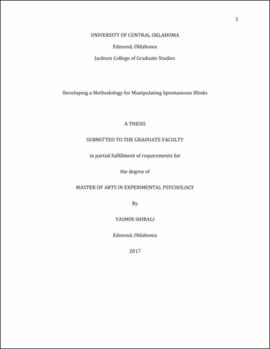| dc.contributor.advisor | Lack, Caleb | |
| dc.contributor.author | Shirali, Yasmin | |
| dc.date.accessioned | 2020-07-09T14:39:59Z | |
| dc.date.available | 2020-07-09T14:39:59Z | |
| dc.date.issued | 2017 | |
| dc.identifier.other | (AlmaMMSId)9982550985102196 | |
| dc.identifier.uri | https://hdl.handle.net/11244/325044 | |
| dc.description.abstract | While blinking is necessary for ocular protection and lubrication, people blink much more than is necessary for routine ocular maintenance. These extra, spontaneous blinks are extremely difficult to manipulate and thus, have remained somewhat of a mystery. In order to determine the effects of spontaneous blinks, a methodology to manipulate them naturally must be created. The aim of this study was to develop such methodology using videos of animated speakers displaying high and low blink rates, and determine whether this influenced participant blink rates. It was expected that watching videos of a speaker's face would manipulate blink rate. It was also expected that participants would imitate the speaker's blink timing and blink immediately after the speaker blinks, called blink entrainment. Participants watched four videos, two featuring an animated speaker with a high blink rate, and two featuring the same animated speaker with a low blink rate. In between the speaker videos, participants completed ten trials of several variations of a lexical decision task. The speaker videos provided instructions on how to complete each of these tasks. A Wilcoxon signed-rank test showed that the differences between participant blink rates across the high blink rate and the low blink rate were significant (Z = -3.16, p = .002). Participants blinked more frequently while watching the high blink rate videos than when watching the low blink rate videos. A Wilcoxon signed-rank test also showed a significant difference between entrainment blinks and non-entrainment blinks in the high blink rate condition (Z = -3.65, p = .001), and the low blink rate condition (Z = -2.21, p = .027). These results indicate that a standardized methodology for manipulating spontaneous blinks is possible. With the use of the animated speaker videos, spontaneous blinks can be manipulated. | |
| dc.rights | All rights reserved by the author, who has granted UCO Chambers Library the non-exclusive right to share this material in its online repositories. Contact UCO Chambers Library's Digital Initiatives Working Group at diwg@uco.edu for the permission policy on the use, reproduction or distribution of this material. | |
| dc.subject.lcsh | Eye | |
| dc.title | Developing a methodology for manipulating spontaneous blinks. | |
| dc.type | Academic theses | |
| dc.contributor.committeeMember | Jeyaraj-Powell, Tephillah | |
| dc.contributor.committeeMember | Hancock, Thomas | |
| dc.contributor.committeeMember | Webster, Kirk | |
| dc.thesis.degree | M.A., Experimental Psychology | |
| dc.subject.keywords | Blinking | |
| dc.subject.keywords | Eye | |
| dc.subject.keywords | Eye tracking | |
| dc.subject.keywords | Spontaneous | |
| dc.identifier.oclc | (OCoLC)on1007546574 | |
| uco.group | UCO - Graduate Works and Theses::UCO - Theses | |
| thesis.degree.grantor | Jackson College of Graduate Studies. | |
